Yankee-class submarine
The Yankee class, Soviet designations Project 667A Navaga (navaga) and Project 667AU Nalim (burbot), was a series of nuclear-powered ballistic missile submarines built in the Soviet Union for the Soviet Navy. In total, 34 units were produced out of 24 built in Severodvinsk for the Northern Fleet and the remaining 10 in Komsomolsk-on-Amur for the Pacific Fleet. Two Northern Fleet units were later transferred to the Pacific.[1] The lead boat K-137 Leninets received its honorific name on 11 April 1970, two and one half years after being commissioned.
 Yankee class SSBN profile | |
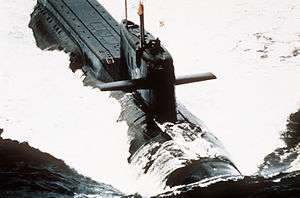 A Yankee Notch submarine underway. | |
| Class overview | |
|---|---|
| Name: | Yankee class |
| Builders: | Severodvinsk and Komsomolsk |
| Operators: |
|
| Preceded by: | Hotel class |
| Succeeded by: | Delta class |
| Built: | 1964–1974 |
| In commission: | 1967–1995 |
| Completed: | 34 |
| Lost: | 1 |
| Retired: | 33 |
| General characteristics | |
| Type: | Ballistic missile submarine |
| Displacement: |
|
| Length: | 132 m (433 ft) |
| Beam: | 11.6 m (38 ft) |
| Draught: | 8 m (26 ft) |
| Propulsion: | two pressurized water cooled reactors powering four steam turbines driving two shafts. |
| Speed: |
|
| Range: | unlimited |
| Complement: | 120 |
| Armament: |
|
Design
The Yankee-class nuclear submarines were the first class of Soviet ballistic missile submarines (SSBN) to have thermonuclear firepower comparable with that of their American and British Polaris submarine counterparts. The Yankee class were quieter in the ocean than were their Hotel-class predecessors, and had better streamlining that improved their underwater performance. The Yankee class were actually quite similar to the Polaris submarines of the U.S. Navy and the Royal Navy. These boats were all armed with 16 submarine-launched ballistic missiles (SLBM) with multiple nuclear warheads as nuclear deterrents during the Cold War, and their ballistic missiles had ranges from 1,500–2,500 nautical miles (2,800–4,600 km; 1,700–2,900 mi).
Operational history
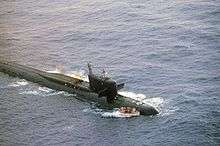
The Yankee-class SSBNs served in the Soviet Navy in three oceans: the Atlantic Ocean, the Pacific Ocean, and the Arctic Ocean beginning in the 1960s. During the 1970s about three Yankee-class were continually on patrol in a so-called "patrol box" in the Atlantic Ocean just east of Bermuda[2] and off the US Pacific coast. This forward deployment of the SSBNs was seen to balance the presence of American, British, and French nuclear weapons kept in Western Europe and on warships (including nuclear submarines) in the surrounding Atlantic Ocean, including the Mediterranean Sea and the Eastern Atlantic.
One Yankee-class submarine, K-219, was lost on 6 October 1986 after an explosion and fire on board. This boat had been at sea near Bermuda, and she sank from loss of buoyancy because of flooding. Four of her sailors died before rescue ships arrived. At least one other boat in this class was involved in a collision with a U.S. Navy nuclear submarine.
Because of their increasing age, and as negotiated in the SALT I, START I and START II treaties that reduce nuclear armaments of the United States and the Soviet Union, all boats of Yankee class were disarmed, decommissioned and sent to the nuclear ship scrapyards.
Variants
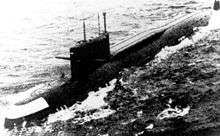
There were eight different versions of the Yankee subs:
- Yankee I (Project 667A): The baseline configuration, these were ballistic missile submarines that first saw service in 1968; 34 were built. The subs carried 16 SS-N-6 missiles, had 6 torpedo tubes, and carried 18 Type 53 torpedoes. They were the first Soviet SSBNs to carry their ballistic missiles within the hull (as opposed to the sail).
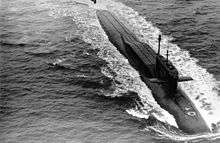
- Yankee II (Project 667AM Navaga M): A single-ship class, this was a Yankee I submarine (K-140) converted to carry 12 SS-N-17 missiles, which was the Soviet Navy's first solid-fuelled SLBM. The existence of this individual prototype led to several theories about the Yankee II having a unique role in the Soviet arsenal that justified maintaining a single ship with such a unique weapon. One theory suggested that it was designed to perform an emergency satellite-launching function. Subsequently, it was proposed that the SS-N-17 may have had a retargeting capability to allow strikes on aircraft carrier battle groups.
- Yankee Notch (Project 667AT Grusha): These converted subs were attack submarines and first appeared in 1983; four Yankee I boats were rebuilt to this configuration. They incorporated a "notch waisted" center section, which replaced the old ballistic missile compartment, featuring eight 533-millimetre (21 in) torpedo tubes for up to 40 SS-N-21 missiles or additional torpedoes. The forward torpedo tubes were retained as well, with some reports suggesting that the vessels may have also been able to fire 650 mm (26 in) Type 65 torpedoes. The emphasis on additional SS-N-21 missile carriage suggested a tactical role for these submarines, or as second-strike nuclear submarines. Their configuration was a combination of SALT treaty limitations (which affected SLBMs but not cruise missiles) and a typical Soviet unwillingness to completely discard any military hardware that might still have some use. The conversion increased the overall length by 12 metres (39.4 ft) to 141.5 m (464 ft), with a displacement of up to 11,500 tons submerged. While classed as SSNs (attack subs), these boats might also be considered SSGNs by virtue of their heavy missile armament.
- Yankee Sidecar (Project 667M Andromeda) Also known as Yankee SSGN, this was another single-ship class (in this case K-420) converted into an SSGN. It appeared in 1983, carrying 12 SS-NX-24 nuclear-tipped cruise missiles instead of the original ballistic missiles. The SS-NX-24 was an experimental cruise missile, with a supersonic flight regime and twin nuclear warheads. It was meant as a tri-service strategic weapon, and thus would have filled a rather different role than the tactically-oriented Oscar-class SSGNs of the same era. In the end, the missile was not adopted, and K-420 became a weapon system without a weapon. It was fully 13,650 tons displacement (dived), and was even longer than the Yankee Notch to accommodate the massive cruise missiles; it was 153 m (502 ft) long overall.
- Yankee SSN 16 of this type were converted from the basic Yankee I specification. Some were not completely converted, although they cannot carry ballistic missiles, so they were called Yankee SSNX. They retained only their forward torpedo tubes, with the central missile sections having been removed. Some are being scrapped.
- Yankee Pod (Project 09774 Akson) The Yankee Pod (also known as the Yankee SSAN) is a converted trials submarine, K-403 Kazan, which was used for sonar equipment, with the namesake pod mounted atop the rudder (a la Victor III-class SSNs). It had other sensor systems incorporated as well, notably alongside the sail.
- Yankee Stretch (Project 09774) K-411, the Yankee Stretch conversion, is a "mothership" for Paltus-class mini-submarines. It is fully 160 m (520 ft) in length, making it the largest of the Yankee conversions. Like the Yankee Pod, it lacked missile armament. Its mission was believed to be a combination of oceanographic research, search and rescue, and underwater intelligence-gathering.[3]
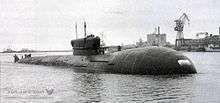
- Yankee Big Nose (Project 09780 Akson-2) is an additional modification of K-403 Kazan for trials of an acoustic system for fourth-generation Russian submarines: the Irtysh sonar system, in combination with the spherical antenna Amfora, occupies the entire nose section of the submarine. Modification of K-415 was started in 1987, but due to the end of the Cold War and lack of funds, was never completed.
General characteristics (Yankee I)
| Wikimedia Commons has media related to Yankee class submarines. |
- Length: 128 m (420 ft)
- Beam: 11.7 m (38 ft)
- Draught: 9 m (30 ft)
- Displacement: 7,760/11,500 tonnes surfaced/dived
- Speed: 28 knots (52 km/h; 32 mph)
- Power plant: 2 VM-4 reactors
- Hull: Low magnetic steel
- Crew: 114
- Compartments: 10
- Armament:
- 6 21 in (533 mm) torpedo tubes for 18 Type 53 torpedoes or mines.
- 16 SS-N-6 liquid-fueled ballistic missiles
Units
| # | Project | Shipyard | Laid down | Launched | Commissioned | Status |
|---|---|---|---|---|---|---|
| K-137 | 667A, 667AU | SEVMASH, Severodvinsk | November 4, 1964 | September 11, 1966 | November 6, 1967 | Decommissioned April 3, 1994 for scrapping[1] |
| K-140 | 667A, 667AM | SEVMASH, Severodvinsk | September 19, 1965 | August 23, 1967 | December 30, 1967 | Decommissioned April 19, 1990 for scrapping[1] |
| K-26 | 667A | SEVMASH, Severodvinsk | December 30, 1965 | December 23, 1967 | September 3, 1968 | Decommissioned July 17, 1988 for scrapping[1] |
| K-32 | 667A | SEVMASH, Severodvinsk | February 25, 1966 | April 25, 1968 | October 26, 1968 | Decommissioned April 19, 1990 for scrapping[1] |
| K-216 | 667A | SEVMASH, Severodvinsk | June 6, 1966 | August 6, 1968 | December 27, 1968 | Decommissioned 1985 for scrapping[1] |
| K-207 | 667A | SEVMASH, Severodvinsk | November 4, 1966 | September 20, 1968 | May 30, 1968 | Decommissioned May 30, 1989 for scrapping[1] |
| K-210 | 667A | SEVMASH, Severodvinsk | December 16, 1966 | December 29, 1968 | August 6, 1969 | Decommissioned July 17, 1988 for scrapping[1] |
| K-249 | 667A | SEVMASH, Severodvinsk | March 18, 1967 | March 30, 1969 | September 27, 1969 | Decommissioned July 17, 1988 for scrapping[1] |
| K-253 | 667A, 667AT | SEVMASH, Severodvinsk | June 26, 1967 | June 5, 1969 | November 28, 1969 | Decommissioned for scrapping[1] |
| K-395 | 667A, 667AT | SEVMASH, Severodvinsk | September 8, 1967 | July 28, 1969 | December 5, 1969 | Decommissioned for scrapping[1] |
| K-339 | 667A | Leninskiy Komsomol Shipyard, Komsomolsk | February 23, 1968 | June 23, 1969 | December 24, 1969 | Decommissioned April 19, 1990 for scrapping[1] |
| K-408 | 667A, 667AT | SEVMASH, Severodvinsk | January 20, 1968 | September 10, 1969 | December 25, 1969 | Decommissioned July 17, 1988 for scrapping[1] |
| K-411 | 667A, 667AN | SEVMASH, Severodvinsk | May 25, 1968 | January 16, 1970 | August 31, 1970 | Decommissioned for scrapping[1] |
| K-418 | 667A | SEVMASH, Severodvinsk | June 29, 1968 | March 14, 1970 | September 22, 1970 | Decommissioned March 17, 1989 for scrapping[1] |
| K-420 | 667A, 667M | SEVMASH, Severodvinsk | October 12, 1968 | April 25, 1970 | October 29, 1970 | Decommissioned for scrapping[1] |
| K-423 | 667A, 667AT | SEVMASH, Severodvinsk | January 13, 1969 | April 7, 1970 | November 13, 1970 | Decommissioned for scrapping[1] |
| K-434 | 667AU | Leninskiy Komsomol Shipyard, Komsomolsk | February 23, 1969 | May 29, 1970 | November 30, 1970 | Decommissioned March 17, 1989 for scrapping[1] |
| K-426 | 667A | SEVMASH, Severodvinsk | April 17, 1969 | August 28, 1970 | December 22, 1970 | Decommissioned April 19, 1990 for scrapping[1] |
| K-236 | 667AU | Leninskiy Komsomol Shipyard, Komsomolsk | November 6, 1969 | August 4, 1970 | December 27, 1970 | Decommissioned September 1, 1990 for scrapping[1] |
| K-415 | 667A, 667AK-2 | SEVMASH, Severodvinsk | July 4, 1969 | September 26, 1970 | December 30, 1970 | Decommissioned August 6, 1987 for scrapping[1] |
| K-403 | 667A, 667AK-1 | SEVMASH, Severodvinsk | August 18, 1969 | March 25, 1971 | August 12, 1971[1] | Decommissioned – Scrapping underway in 2010 [4] |
| K-389 | 667A | Leninskiy Komsomol Shipyard, Komsomolsk | July 26, 1970 | June 27, 1971 | November 25, 1971 | Decommissioned April 19, 1990 for scrapping [1] |
| K-245 | 667AU | SEVMASH, Severodvinsk | October 16, 1969 | August 9, 1971 | December 16, 1971 | Decommissioned March 14, 1992 for scrapping[1] |
| K-219 | 667AU | SEVMASH, Severodvinsk | May 28, 1970 | October 8, 1971 | December 31, 1971[1] | Lost October 3, 1986 |
| K-252 | 667A | Leninskiy Komsomol Shipyard, Komsomolsk | December 25, 1970 | September 12, 1971 | December 31, 1971 | Decommissioned March 17, 1989 for scrapping [1] |
| K-214 | 667AU | SEVMASH, Severodvinsk | February 19, 1970 | September 1, 1971 | February 8, 1972 | Decommissioned June 24, 1991 for scrapping [1] |
| K-228 | 667AU | SEVMASH, Severodvinsk | September 4, 1970 | May 3, 1972 | September 30, 1972 | Decommissioned September 3, 1994 for scrapping [1] |
| K-258 | 667AU | Leninskiy Komsomol Shipyard, Komsomolsk | March 30, 1971 | May 26, 1972 | September 30, 1972 | Decommissioned June 16, 1991 for scrapping [1] |
| K-241 | 667AU | SEVMASH, Severodvinsk | December 24, 1970 | June 9, 1972 | October 23, 1972 | Decommissioned June 16, 1992 for scrapping [1] |
| K-444 | 667AU | SEVMASH, Severodvinsk | April 8, 1971 | August 1, 1972 | December 23, 1972 | Decommissioned September 30, 1994 for scrapping [1] |
| K-446 | 667AU | Leninskiy Komsomol Shipyard, Komsomolsk | November 7, 1971 | August 8, 1972 | January 22, 1973 | Decommissioned March 17, 1993 for scrapping [1] |
| K-451 | 667AU | SEVMASH, Severodvinsk | February 23, 1972 | April 29, 1973 | September 7, 1971 | Decommissioned June 16, 1991 for scrapping [1] |
| K-436 | 667AU | Leninskiy Komsomol Shipyard, Komsomolsk | November 7, 1972 | July 25, 1973 | December 5, 1973 | Decommissioned March 14, 1992 for scrapping [1] |
| K-430 | 667AU | Leninskiy Komsomol Shipyard, Komsomolsk | July 27, 1973 | July 28, 1974 | December 25, 1974 | Decommissioned January 12, 1995 for scrapping [1] |
References
- Korabli VMF SSSR, Vol. 1, Part 1, Yu. Apalkov, Sankt Peterburg, 2003, ISBN 5-8172-0069-4
- "Title unknown". The Royal Gazette. Archived from the original on March 29, 2006.
- "Paltus Class – Project 1083.1". Federation of American Scientists. Retrieved 2012-08-10.
- 64.586°N 39.8187°E
External links
- National Geographic: Yankee class accessed March 14, 2004.
- NATO Code Names for Submarines and Ships accessed March 14, 2004.
- Federation of American Scientists: Yankee class accessed June 11, 2006.
- Bellona Report: Project 667 A (Nalim, Navaga) – Yankee Class accessed June 11, 2006.
- World Navies Today: Russian Submarines accessed June 11, 2006.
- Jane's Fighting Ships of the World, 1994.